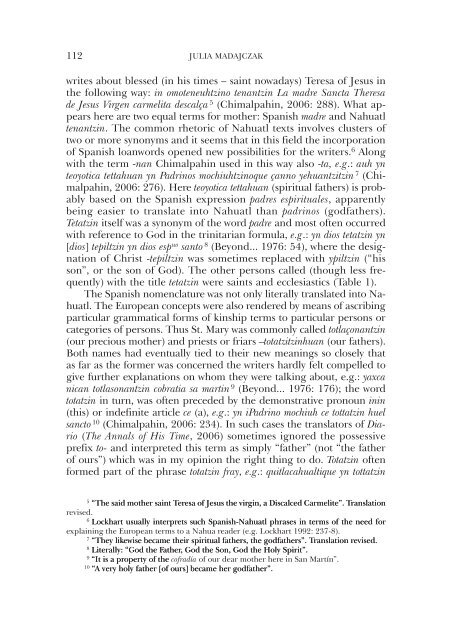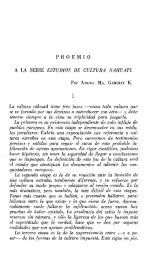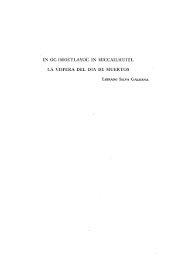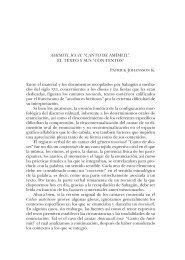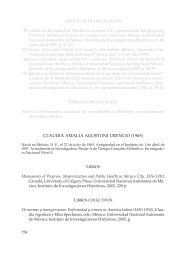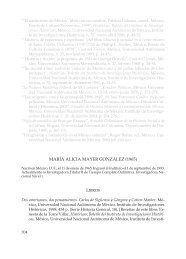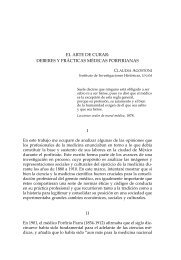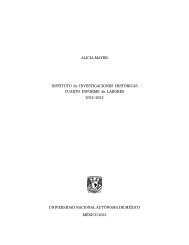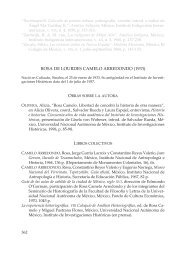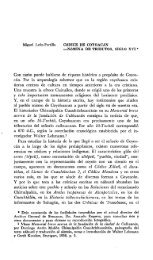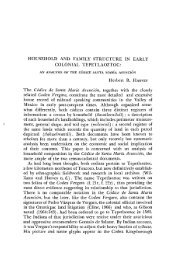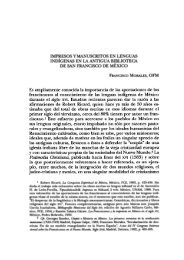“HOLY FAMILY”. THE NAHUATL KINSHIP TERMS IN THE ...
“HOLY FAMILY”. THE NAHUATL KINSHIP TERMS IN THE ...
“HOLY FAMILY”. THE NAHUATL KINSHIP TERMS IN THE ...
Create successful ePaper yourself
Turn your PDF publications into a flip-book with our unique Google optimized e-Paper software.
112 Julia Madajczak<br />
writes about blessed (in his times – saint nowadays) Teresa of Jesus in<br />
the following way: in omoteneuhtzino tenantzin La madre Sancta Theresa<br />
de Jesus Virgen carmelita descalça (Chimalpahin, 2006: 288). What appears<br />
here are two equal terms for mother: Spanish madre and Nahuatl<br />
tenantzin. The common rhetoric of Nahuatl texts involves clusters of<br />
two or more synonyms and it seems that in this field the incorporation<br />
of Spanish loanwords opened new possibilities for the writers. Along<br />
with the term -nan Chimalpahin used in this way also -ta, e.g.: auh yn<br />
teoyotica tettahuan yn Padrinos mochiuhtzinoque çanno yehuantzitzin (Chimalpahin,<br />
2006: 276). Here teoyotica tettahuan (spiritual fathers) is probably<br />
based on the Spanish expression padres espirituales, apparently<br />
being easier to translate into Nahuatl than padrinos (godfathers).<br />
Tetatzin itself was a synonym of the word padre and most often occurred<br />
with reference to God in the trinitarian formula, e.g.: yn dios tetatzin yn<br />
[dios] tepiltzin yn dios esp uo santo (Beyond... 1976: 54), where the designation<br />
of Christ -tepiltzin was sometimes replaced with ypiltzin (“his<br />
son”, or the son of God). The other persons called (though less frequently)<br />
with the title tetatzin were saints and ecclesiastics (Table 1).<br />
The Spanish nomenclature was not only literally translated into Nahuatl.<br />
The European concepts were also rendered by means of ascribing<br />
particular grammatical forms of kinship terms to particular persons or<br />
categories of persons. Thus St. Mary was commonly called totlaçonantzin<br />
(our precious mother) and priests or friars –totatzitzinhuan (our fathers).<br />
Both names had eventually tied to their new meanings so closely that<br />
as far as the former was concerned the writers hardly felt compelled to<br />
give further explanations on whom they were talking about, e.g.: yaxca<br />
nican totlasonantzin cobratia sa martin (Beyond... 1976: 176); the word<br />
totatzin in turn, was often preceded by the demonstrative pronoun inin<br />
(this) or indefinite article ce (a), e.g.: yn iPadrino mochiuh ce tottatzin huel<br />
sancto 10 (Chimalpahin, 2006: 234). In such cases the translators of Diario<br />
(The Annals of His Time, 2006) sometimes ignored the possessive<br />
prefix to- and interpreted this term as simply “father” (not “the father<br />
of ours”) which was in my opinion the right thing to do. Totatzin often<br />
formed part of the phrase totatzin fray, e.g.: quitlacahualtique yn tottatzin<br />
<br />
“The said mother saint Teresa of Jesus the virgin, a Discalced Carmelite”. Translation<br />
revised.<br />
<br />
Lockhart usually interprets such Spanish-Nahuatl phrases in terms of the need for<br />
explaining the European terms to a Nahua reader (e.g. Lockhart 1992: 237-8).<br />
<br />
“They likewise became their spiritual fathers, the godfathers”. Translation revised.<br />
<br />
Literally: “God the Father, God the Son, God the Holy Spirit”.<br />
<br />
“It is a property of the cofradía of our dear mother here in San Martín”.<br />
10<br />
“A very holy father [of ours] became her godfather”.


